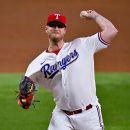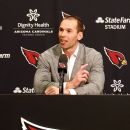Preaching patience with Bobby Witt Jr. and Julio Rodriguez
Change demands adjustments, even for the most experienced of us.
With the advent of ESPN’s new standard league settings, shrinking starting lineups and putting more of an emphasis on the game’s truly elite performers while filling free-agent lists with a greater amount of talent, the time-old strategy of “patience” with struggling stars in fantasy leagues demands a reexamination. After all, why wait on a player who isn’t performing, when there’s almost always a readily available replacement who is delivering those much-needed stats?
Evaluating that balance has been difficult, admittedly even for this columnist. Nowadays, there’s a very realistic chance that a fantasy team could have exited its draft with a lineup full of superstars, several of whom have collectively underperformed to the point that the overall result has the team looking up in the standings, facing a large gap between itself and first place.
To illustrate, I’ve got a team this season that exited the draft with the following seven players: Sandy Alcantara, Xander Bogaerts, Emmanuel Clase, Vladimir Guerrero Jr., Julio Rodriguez, Mike Trout, Bobby Witt Jr. It’s currently 2-5 and in last place. In fairness, that’s a six-team family league, meaning one even richer in talent on the free agent list than ESPN’s new standard.
However, to strengthen the point, in our 10-team, standard office league, I’m also staring at a largely underperforming roster (Trout, Carlos Correa, J.T. Realmuto, Austin Riley, Max Scherzer) and yet another 2-5 record (although three of those were by heartbreaking single-digit margins). So, I’m faced with the difficult decision of when and whether to move on from each of these usually very talented players. Regardless of the individual names involved, or the relative depth of the free-agent pool in either league, the difference in playing style demands an adjusted approach.
Patience no longer a virtue?
In seasons past, my approach was to remain as patient as possible with my largest draft-day investments, to the point that I once suggested a “regret rule,” effectively inverting the 1-23 order by round of your draft picks, with the resulting number being the number of weeks you should remain patient with the player (extenuating circumstances — such as injuries — excepted, of course). Nowadays, with so many different league styles, and the rising number of shallow mixed leagues, patience needs be taken on a case-by-case basis. There is absolutely nothing wrong with trying something different if what you’re trying isn’t working, and in a mixed league, there’s much more opportunity for experimenting.
Before taking a deeper dive into those struggling stars, a quick aside: There’s an old-school contingent that might scoff at shallow leagues, but trying as many different varieties of game play does improve your strategizing skills. There’s a reason I play in that six-team league — besides the appeal of, as Vin Diesel preaches, family — just as there’s a reason that not any one of my 11 non-sim leagues this season is identical in format. Engaging in the expanding number of styles of fantasy baseball game play not only gives a better feel of which types is best suited to each of us, it helps us better understand the breadth and importance of players’ specific skill sets.
The new standard mixed league, for instance, has caused me to take numerous different looks at small sample sizes, not to mention invest a greater amount of attention to the individual game matchups. Both of those are immensely beneficial — including having provided a needed boost to some of my other, more old-school leagues.
Stick with these guys
Back to the players, a few of those mentioned earlier from my six-team league are, despite this team’s poor year-to-date performance, ones who still strike me as “go down with the ship” types. Here’s what stands out upon closer analysis of each:
 Bobby Witt Jr., SS, Kansas City Royals: An 8-for-45 (.178 BA), 11-game slump from May 10-21 dropped Witt out of the top three spots in the batting order for the first time all year on Monday, in what has overall been a disappointing season for the top-40 overall preseason pick (and top-10 in NFBC rotisserie formats). However, just to illustrate what “disappointing” looks like for a No. 2 overall draft pick (2019) and No. 2 overall prospect in baseball (at the time of his 2022 debut), Witt is still the No. 68 hitter in terms of fantasy points, and No. 50 player overall on the ESPN Player Rater.
Bobby Witt Jr., SS, Kansas City Royals: An 8-for-45 (.178 BA), 11-game slump from May 10-21 dropped Witt out of the top three spots in the batting order for the first time all year on Monday, in what has overall been a disappointing season for the top-40 overall preseason pick (and top-10 in NFBC rotisserie formats). However, just to illustrate what “disappointing” looks like for a No. 2 overall draft pick (2019) and No. 2 overall prospect in baseball (at the time of his 2022 debut), Witt is still the No. 68 hitter in terms of fantasy points, and No. 50 player overall on the ESPN Player Rater.
Possessing seasonal paces of 23 home runs and 45 stolen bases will do that for a hitter and bear in mind that, despite his beneath-his-rookie-year batting rates, Witt’s Statcast Barrel, hard-hit and average exit velocity rates have all noticeably improved during his sophomore season. Statcast identifies him as one of the more unlucky hitters in baseball on batted balls, with an expected wOBA 37 points beneath his true wOBA (.326 versus .289).
Witt turns just 23 years old in three weeks, so isn’t it conceivable he could be one of those soon-to-be-megastars who takes incremental steps on said journey? Even if that’s ultimately his route, patience is mandatory (even if maddening) as there are far too many signals of a potential overnight breakthrough, too.
 Emmanuel Clase, RP, Cleveland Guardians: He has already blown more save opportunities this season (5) than he did all of last (4), but perhaps his most telling statistic this year is that he at one point faced 27 consecutive batters without striking out any of them, after striking out 27.5% of the hitters he faced in 2021-22 combined. Still, Clase has been effective enough in the closer role to put himself on pace for 54 saves — a total that has been exceeded only five times in history.
Emmanuel Clase, RP, Cleveland Guardians: He has already blown more save opportunities this season (5) than he did all of last (4), but perhaps his most telling statistic this year is that he at one point faced 27 consecutive batters without striking out any of them, after striking out 27.5% of the hitters he faced in 2021-22 combined. Still, Clase has been effective enough in the closer role to put himself on pace for 54 saves — a total that has been exceeded only five times in history.
Yes, it is a concern that his velocity is down this year, a little more than 1 mph on both his cutter and slider, and his slider has seen a noticeable decline in spin rate. Clase does, however, have a history of similarly length funks in both of his previous two seasons as Guardians closer, and last year, he had a similar ERA through this stage of the year — 2.76 on the morning of May 24, 0.96 thereafter. His skill set and raw metrics say he’s still the wisest ninth-inning choice on the roster.
 Julio Rodriguez, OF, Seattle Mariners: After a hot, three-week start to the season, the defending AL Rookie of the Year and No. 3 prospect overall at the time of his big-league debut has run cold, batting only .178/.272/.317 with three home runs, three stolen bases and a 29.8% strikeout rate over his past 26 games. Like Witt, however, Rodriguez still finds himself on pace for a solid 24 homers and 27 steals, his Statcast quality-of-contact metrics are well within range of his rookie-year rates, and he has been graded even more unlucky than Witt, with a wOBA 42 points beneath his expected number (.300 versus .342).
Julio Rodriguez, OF, Seattle Mariners: After a hot, three-week start to the season, the defending AL Rookie of the Year and No. 3 prospect overall at the time of his big-league debut has run cold, batting only .178/.272/.317 with three home runs, three stolen bases and a 29.8% strikeout rate over his past 26 games. Like Witt, however, Rodriguez still finds himself on pace for a solid 24 homers and 27 steals, his Statcast quality-of-contact metrics are well within range of his rookie-year rates, and he has been graded even more unlucky than Witt, with a wOBA 42 points beneath his expected number (.300 versus .342).
Rodriguez’s issues appear tied primarily to his aggressiveness at the plate, as his chase rate places in the 16th percentile, and his 42% chase rate when in hitters’ counts has been exceeded by only five other batting title-eligible hitters this year. These are fixable things, and not uncommon from generally aggressive swingers when they’re in the midst of funks. Rodriguez has far too much talent, a combination of raw power and elite speed that few other players possess, to expect him to continue at this modest level.
Sure to have a Turner-round?
Oh, and here’s one more player who, while not on my six-teamer, is on many of my rosters and will continue to be on them for the proverbial long haul:
 Trea Turner, SS, Philadelphia Phillies: He had a stellar World Baseball Classic, a standout spring training, delivered five multi-hit performances in his first seven and 10 in his first 19 regular-season games and then … practically nothing. Turner has inexplicably batted .203/.242/.339 with three homers, nine runs scored and two stolen bases — two!!! — over his last 28 games, getting outscored in points leagues by Enrique Hernandez, Kevin Newman and Miguel Rojas during that time. It’s a huge letdown for a player who was a universal top-five overall pick regardless of format.
Trea Turner, SS, Philadelphia Phillies: He had a stellar World Baseball Classic, a standout spring training, delivered five multi-hit performances in his first seven and 10 in his first 19 regular-season games and then … practically nothing. Turner has inexplicably batted .203/.242/.339 with three homers, nine runs scored and two stolen bases — two!!! — over his last 28 games, getting outscored in points leagues by Enrique Hernandez, Kevin Newman and Miguel Rojas during that time. It’s a huge letdown for a player who was a universal top-five overall pick regardless of format.
Taking a closer look, however, Turner looks like a classic hitter who has been pressing, understandable for an individual who signed an 11-year, $300 million contract during the preceding winter. His swing (54%) and chase (37%) rates represent easily his highest numbers in any of nine seasons, both at least 6% greater than his career numbers. Again, these are things that can be corrected.




